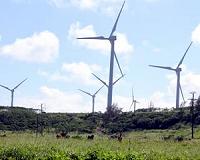 |
New Delhi (UPI) Mar 23, 2011 India's private energy giant Tata Power has joined with Australia's Sunengy Pty Limited for a $1 million pilot project to build a solar-powered electricity generation plant that will float on water, the companies announced. "In our quest to deliver sustainable energy, Tata Power is consistently investing in clean and eco-friendly technologies," Tata Executive Director Banmali Agrawala said in a statement. The plant would use Sunengy's Liquid Solar Array technology, based on traditional concentrated photovoltaic technology, incorporating a lens and a small area of solar cells that track the sun throughout the day. The solar panels float on water, which reduces the need for supporting structures while offering protection from high winds, Sunengy says. In bad weather, the lenses submerge in the water, which also cools the cells, thus increasing their life span and efficiency. Phil Connor, Sunengy's executive director and chief technology officer said its system "is effectively cyclone proof." While the location of the project in India wasn't disclosed, Agrawala said the technology would be demonstrated in the natural environment. "It utilizes the water surface for mounting and does not compete with land that can be used for other purposes," he said. Sunengy says the principal market for the floating solar system is industrial scale electricity via hydropower stations. Other markets include mining sites as well as remote areas that rely on diesel-powered generators for electricity. "Liquid Solar Array effectively turns a dam into a very large battery, offering free solar storage and (an) opportunity for improved water resource management," Connor said. If India were to use 1 percent of its 11,583 square miles of captured water with Sunengy's system, he said, it could generate power equal to 15 large coal-fired power stations. Construction on the Indian pilot plant is expected to start in August. Sunengy is also planning a larger $2 million system in New South Wales, Australia, in mid 2012 before going into full production. As part of its solar mission announced last January, India aims to have 20,000 megawatts of grid-connected solar energy by 2022, up from about 2 megawatts now. India, the world's third largest emitter of greenhouse gases, relies on coal for more than half of its power capacity. Nearly 40 percent of Indian households have no access to electricity.
Share This Article With Planet Earth
Related Links All About Solar Energy at SolarDaily.com
 Wind And Solar Can Reliably Supply 25 Percent Of Oahu's Electricity Need
Wind And Solar Can Reliably Supply 25 Percent Of Oahu's Electricity NeedManoa HI (SPX) Mar 23, 2011 When combined with on-Oahu wind farms and solar energy, the Interisland Wind project planned to bring 400 megawatts (MW) of wind power from Molokai and Lanai to Oahu could reliably supply more than 25% of Oahu's projected electricity demand, according to the Oahu Wind Integration Study (OWIS). For the purposes of the research project, the OWIS studied the impact on the Oahu grid of a total ... read more |
|
| The content herein, unless otherwise known to be public domain, are Copyright 1995-2010 - SpaceDaily. AFP and UPI Wire Stories are copyright Agence France-Presse and United Press International. ESA Portal Reports are copyright European Space Agency. All NASA sourced material is public domain. Additional copyrights may apply in whole or part to other bona fide parties. Advertising does not imply endorsement,agreement or approval of any opinions, statements or information provided by SpaceDaily on any Web page published or hosted by SpaceDaily. Privacy Statement |